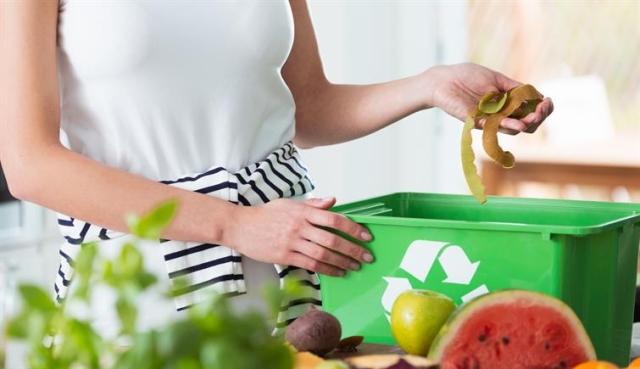Did you know that 95 percent of the food thrown out in the U.S. ends up in a landfill? How about the fact that 20 to 30 percent (the largest percentage) of what we throw away is food? All of that tossed-out food sitting around in landfills creates methane gas, one of the largest contributors to global warming. In order to cut back on the amount of food piling up in landfills, some people are looking at ways to reduce and even reuse food waste. In comes the compost bin! Well, hold on. First, what the heck is composting? And isn’t that just for farmers or people with lots of land? Surely I can’t compost in a high-rise … can I? Well, you’d be surprised. Here’s everything you ever wanted to know about composting (and, well, to be honest, probably a few things you didn’t want to know).
What is compost?
In a nutshell (which can be composted, by the way), compost is decayed organic material that is used to fertilize plants. Gardeners love it and often refer to compost as “black gold” because it makes plants healthy and strong (kind of like spinach for Popeye). No two batches of compost are the same – the outcome depends on what’s used, so your plants get a variety of nutrients. You’ll want an equal mix of green and brown material. The “brown” (think newspaper, paper bags, paper towels, twigs, coffee filters, nutshells, and leaves) helps keep moisture down and eliminates any odor. The “green” (all of that food waste, like egg shells, fruit and veggie scraps, and coffee grounds) break down to make the beautiful, rich compost.
While you always need the right balance of green and brown, the methods beyond that differ. There are several composting techniques, but the basic ones are anaerobic composting, aerobic composting, and vermicomposting. You might also hear the terms in-vessel composting, static-pile composting, hot composting, and bokashi composting. Here’s how these common methods work:
- Aerobic Composting: This breaks the material down faster, but your compost needs to be turned every few days (this is where the farmer-with-a-pitchfork image comes into play). You can also use a composter that tumbles – it has a handle on the end so you can spin it.
- Anaerobic Composting: This is the easiest method because you don’t do anything – just toss food scraps into a compost bin and wait … and wait … and oh, wait! This actually stinks! This is the easiest method, but it is also the longest and the most odoriferous of methods.
- Vermicomposting: This type of composting involves worms. The most common type of worms are the red wiggler worms. There’s very little odor, you don’t have to turn the compost frequently, and there’s very little bacteria or methane to worry about. While it may seem counterintuitive (because, well, worms), this is the easiest and cleanest method of composting. And, hey, pets … well, sort of.
- Bokashi Composting: This is a fermenting process that produces a “tea” for your plants. The plus side to this type of composting is that all things can be added – including meat and dairy, big no-nos in other types of composting. This system basically mixes the food scraps with a grain, like bran. You’ll need a special Bokashi composter – it has a spigot on it so you can drain the fluid every few days and use it on your plants. After about 10 days, you can bury the material in the ground, but it shouldn’t come into direct contact with the roots of plants for several weeks because it is so acidic. This method is great for apartment dwellers because there’s little odor and you can do it in a very small space, but it isn’t ideal for apartment dwellers because you can’t apply the compost directly to plants – you have to bury it in a trench outside. So unless you have a patch of yard or access to a community garden, this might not be the best option.
- In-Vessel Composting: This is basically composting in large batches using a container of some type. This is most commonly used by large food processing plants.
- Static-Pile Composting: Basically what it sounds like: a giant pile of compost. This is the preferred method of governments, landscapers, and farmers. You won’t be doing this in your apartment.
- Hot Composting: This involves heating the compost through a balance of carbon and nitrogen, some water, and ample sunlight. The benefit is it takes weeks instead of months to make compost. However, you’d need a lot of compost for this method to work properly, and it’s best to build the pile all at once to get it to heat up. The recommended bin for hot composting is 4 feet wide by 4 feet high – probably not the best option for your apartment.
What Can You Compost?
Now that you’ve chosen a method, here’s a list of things you can compost:
- Eggshells
- Vegetable scraps
- Non-citrus fruit scraps
- Melon rinds
- Coffee grounds
- Pasta
- Shredded newspaper
- Cardboard rolls, paper bags, cereal boxes
- Paper towels
- Dryer lint
- Nut shells
- Tea, teabags
- Wood chips
- Sawdust (untreated wood only)
- Dry leaves
- Grass and plant clippings
What You Can’t Compost:
- Meat (Including fish and poultry)
- Dairy
- Grease, oils, and fats
- Leftovers with salt, spices
- Pet waste
- Charcoal
- Anything treated with pesticides
- Black walnut tree leaves or twigs
- Any insect-ridden or diseased plants
Wait, what about the worms?
You’ll only add worms if you’re vermicomposting. Vermicomposting works like this: Get a bin and drill some holes in it. Cover the holes with mesh so the worms can’t escape (you need the holes for drainage). Place the bin on a tray so the drainage doesn’t get on your floor (or counter). Shred some newspaper and soak it in water. Put this in the bin and add your red wigglers (the worms). You’ll need a pound of worms for every square foot of bin. Feed your worms by adding your food scraps. In a few months, get your compost (careful not to dig up your worms). Add new newspaper shreds and start the process again. You can add a layer of dirt and moist paper over the food scraps when composting – this cuts down on pests, like fruit flies, coming to investigate your compost bin.
This bin can go anywhere cool in your apartment. If you don’t want this bin in your kitchen, consider placing it on your balcony (as long as the weather isn’t too warm or too cold, and if you are using worms, it isn’t in direct sunlight).
If you’re using worms, don’t add garlic, onion, citrus, bones, or chili to your compost bin – it isn’t good for the worms. Don’t put too much in your composting bin – the worms won’t be able to eat it all, and that could lead to bad smells and flies.
Take care of your worms! After all, they’re your wiggly pets now. They need good air flow (make sure you have plenty of holes in the sides and top of the bin), fluff their bedding every now and again (make sure there’s enough of it), and keep the bin in a cool, comfy place – no direct sun because it will get too hot in the bin. Make sure you are feeding them enough (again, not too much – but too little and your worms will become sluggish). Worms eat about half their weight each day, so if you start with one pound of worms, you’ll want to add about half a pound of food scraps each day. To help them eat a little faster, chop the food up into tiny pieces or put it in a blender before adding it to your compost bin. Wait until they consume the food before adding more. (Worms don’t have teeth so the food needs to be tiny or very soft.)
Worms want a damp environment, so keep a spray bottle handy and give the bedding a good spritz whenever you add material to the compost bin. Worms breathe through their skin, so if their area is too dry they could suffocate. Make it too wet and they’ll drown.
What to Do with All of Your Compost
After a month or so, you may discover that you have way more compost than you need – you only have a couple of houseplants, after all. If you end up with an abundance, share the wealth – pass that “black gold” on to friends and neighbors or donate it to a local nursery, a school, or community garden.
Published March 18, 2019






